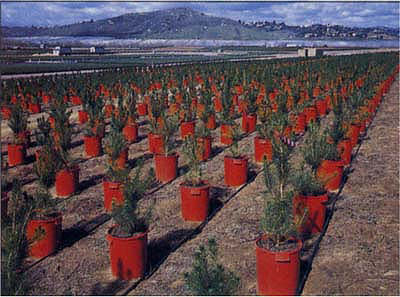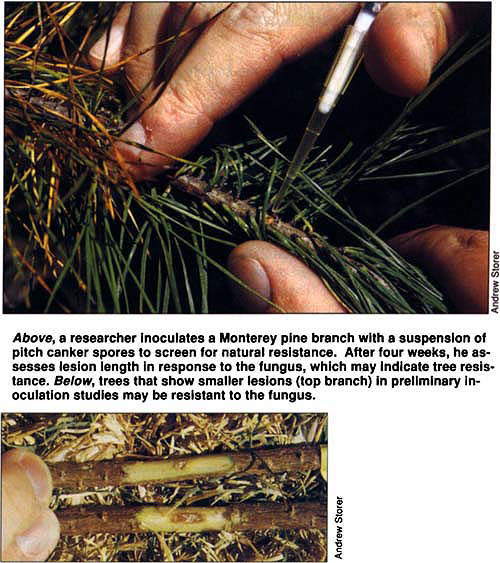All Issues
Research update: ‘Grinch’ fungus threatens Christmas trees
Publication Information
California Agriculture 48(6):4-5.
Published November 01, 1994
PDF | Citation | Permissions
Full text
Sneaking in like the Grinch, a fungal disease is quietly stealing a symbol of Christmas, the Christmas tree. Monterey pine, California's most popular variety of Christmas tree, is increasingly falling victim to pitch canker disease. First recorded in California in 1986, the disease has greatly expanded its host and geographic range, according to UC Berkeley entomologist Andrew Storer ( see page 9 ).
The disease is particularly threatening to California's choose-and-cut Christmas tree industry, which is primarily comprised of small farms of fewer than 20 acres each. The fragrant evergreens with their long needles grow well in a variety of California climates and make up about 70% of the industry.
The development of resistant tree varieties offers the best chance for long-term management, Storer said. In the meantime, because pitch canker now infects other pine species and has made the jump to Douglas fir, he discourages landscape plantings of Monterey pine and other pine species in infested regions.
Pitch canker is killing trees at some Southern California lots where patrons can cut their own Christmas tree. At nurseries like this one, which raises container-grown Monterey pines, growers are keeping an eye out for signs of the disease.
Pitch canker was first identified in California in Santa Cruz County. Since then, it has been spotted as far north as Mendocino County and as far south as San Diego County. Santa Cruz and southern Alameda counties have been hit the hardest, with 85% infestation of the popular landscape tree and its native growths, according to Storer.
Certified arborist Brian Jacobson, of Carmel, described pitch canker, which has ravaged pines along the Highway 1 corridor, as the beginnings of a “horticultural Armageddon.” A moratorium on planting pine species on residential lots will have a profound effect on the plant palate of landscape designers, he said. He noted that native plant enthusiasts and preser-vationists believe that replanting should continue in forested stands.
However, Jacobson thinks that a moratorium on moving Monterey Pine plant material is important. “If pitch canker gets into the Sierra Nevada Mountains, it could decimate the timber industry and the national forest,” he said.
In Southern California — except for an isolated infestation in Santa Barbara County — only Monterey pine Christmas tree farms have been affected.
“It has not hurt us a lot… but it is a potential catastrophe,” said Roger Schafer, past president of California Christmas Tree Growers. In Southern California, where he farms, Schafer's chapter polled members and some nonmembers. Six farms out of about 80 choose-and-cut farms had some evidence of pitch canker, he said. At some farms the disease was limited to one or two trees. However, in one case, an Orange County operation made up of multiple farms, 40% of about 3,000 trees were infected at one site.
In another worst case scenario, Ira “Bud” Lyon, of Rosemead, had to remove more than 6,700 trees from eight farming locations last year at a loss of over $100,000. He abandoned three locations, about 30% of his total tree operation, at the end of 1993, mostly due to pitch canker. This year, as of September 1, the disease has taken 2,300 of his trees, a $42,000 toll. It takes at least 4 years to grow a commercial Christmas tree. Pitch canker doesn't seem to discriminate based on age, but Lyon said it is especially disconcerting to lose older trees.
Because there are currently no proven preventive measures, growers fear that it will continue to spread. To stem the spread, if it is confined to a branch, growers cut off the affected branch. If the canker appears on the trunk, they remove the whole tree. UC's Storer recommends removing infected trees, then burning them or burying them deep in the ground to kill insects and eliminate a reservoir of the pathogen.
Schafer, owner of El Sobrante Christmas Trees near Riverside, said he hasn't seen any signs of pitch canker in his trees. He reasoned that it may be due to the farm being surrounded by citrus and oaks rather than susceptible conifers.
Pitch canker is caused by the fungus Fusarium subglutinans f. sp. pini. In Christmas trees, infection usually occurs at the trunk and rapidly kills the tree. In landscape and native stands, needles on the tips of infected branches turn color and fall off the tree. After the branch dies, cankers weeping with resin usually appear. The disease can eventually kill the entire tree.
“Tree pruning and soil contamination don't appear to be major contributors to the spread of the disease in Christmas trees,” Storer said. “It is suspected that insects may be spreading the disease, because the pitch canker fungus has been found on a number of beetle species commonly associated with Monterey pine and several other trees.” The pathogen has also been detected in several predators and parasites of the beetles. Researchers think insects carrying the fungus introduce it to trees as they mine the bark.
Under this assumption, Storer is trying to deter beetles from feeding on the trees. One technique involves placing an anti-attractant compound, which makes the tree unattractive to bark beetle species, in a plastic cup next to the tree. Another is painting a sticky substance on the lower part of the tree trunk to snag beetles crawling up from the ground and prevent them from feeding on the base of the tree.
Christmas tree grower Lyon said preliminary results of Storer's research are encouraging. With UC test plots on a 23-acre parcel of his land, he noted, “Some of the experiments with UC are helping. The anti-attractant seems to be working.”
Storer presented his findings to the California Christmas Tree Growers association in September. Association president Sam Minturn said he was not aware of any problems in the Central Valley. A tree will often die and the grower may not know why, but with pitch canker they can see a pattern, said Minturn, who farms in Hilmar, just south of Modesto. “One fellow said he was losing a tree a day,” he said. “From the time a tree was infected, it took about 2 weeks to die.”
Minturn said it's too early to tell how the disease will affect the industry. He doesn't think pitch canker will affect the overall supply of Christmas trees this year, but it may next year.
Above, a researcher inoculates a Monterey pine branch with a suspension of pitch canker spores to screen for natural resistance. After four weeks, he assesses lesion length in response to the fungus, which may indicate tree resistance. Below, trees that show smaller lesions (top branch) in preliminary inoculation studies may be resistant to the fungus.
Schafer agreed, “I don't think it will affect Christmas tree prices this year, but next year it might. If everyone gets it, then prices will go up. If only one guy gets it, he'll have to absorb the cost. That could be devastating to a small farm.”
“The scary thing is that it also affects Douglas fir,” said Minturn. In the past, he said, Northern California growers have switched from Monterey pine to Douglas fir when confronted with diseases such as gall rust, but there are no viable alternatives in the case of pitch canker.
Storer and other UC researchers are screening for pine canker resistance in native Monterey pine stands. “We think 10 to 15% of the trees in native stands are resistant,” he said. They hope to breed a resistant species of Monterey pine for commercial production in the future.
Storer is currently conducting a scientific survey of Christmas tree growers to find out how the disease is affecting the industry. —Ed.






